Why Cub Cadet LGTX1054 engine hesitates at high RPM?
- DDavid BlakeSep 10, 2025
If your Cub Cadet Lawn Mower engine hesitates at high RPM, it could be because the spark plug gap is too close. To fix this, remove the spark plug and reset the gap.

Why Cub Cadet LGTX1054 engine hesitates at high RPM?
If your Cub Cadet Lawn Mower engine hesitates at high RPM, it could be because the spark plug gap is too close. To fix this, remove the spark plug and reset the gap.
What to do if Cub Cadet LGTX1054 engine overheats?
If your Cub Cadet Lawn Mower engine is overheating, start by checking the engine oil level and fill the crankcase with the correct amount and weight of oil. Also, ensure that there is no restriction of the air flow. Clean any grass clippings and debris from around the engine’s cooling fins and blower housing.
Why is my Cub Cadet LGTX1054 experiencing excessive vibration?
Excessive vibration in your Cub Cadet Lawn Mower could be due to a loose or unbalanced cutting blade, so tighten the blade and spindle. It may also be caused by a damaged or bent cutting blade, in which case you should replace the blade.
What to do if my Cub Cadet LGTX1054 will not mulch grass?
If your Cub Cadet Lawn Mower isn't mulching grass effectively, there are several possible causes. First, make sure the engine speed isn't too low by placing the throttle in the FAST position. Avoid mulching when the grass is wet. If the grass is excessively high, mow once at a high cutting height, then mow again at the desired height, or make a narrower cutting swath. Finally, a dull blade can hinder mulching, so sharpen or replace it.
Why does my Cub Cadet Lawn Mower engine hesitate at high RPM?
If your Cub Cadet Lawn Mower engine hesitates at high RPM, it could be due to the spark plug(s) gap being too close. Remove the spark plug(s) and reset the gap.
Why my Cub Cadet LGTX1054 Lawn Mower engine fails to start?
If your Cub Cadet Lawn Mower engine won't start, possible causes include: the PTO/Blade Engage knob is engaged, the parking brake isn't engaged, spark plug wires are disconnected, the throttle isn't in the correct starting position, the choke isn't activated, the fuel tank is empty or the fuel is stale, the fuel line is blocked, the spark plug is faulty, the engine is flooded, or a fuse is blown. To resolve this, try the following: Ensure the PTO/Blade Engage knob is disengaged, engage the parking brake, connect the spark plug wires, place the throttle in the FAST position, move the Throttle/Choke Control into choke position, fill the tank with fresh gas (less than 30 days old), clean the fuel line and replace the fuel filter, clean or replace the spark plug, crank the engine with the thro...
| Brand | Cub Cadet |
|---|---|
| Model | LGTX1054 |
| Category | Lawn Mower |
| Language | English |
General guidelines for safe machine use and operator responsibilities.
Guidelines and warnings for operating the tractor on slopes safely.
Safety precautions regarding children around the machine and for towing.
Explanation of safety symbols and how to use the slope gauge.
Procedures for setting up the tractor, including manual movement and brace removal.
Connecting battery cables, checking tire pressure, and adjusting deck gauge wheels.
Adjusting the operator's seat and checking fuel and oil levels.
Explanation of key controls like throttle, brake, and seat adjustment.
Operation of deck lift, ignition switch, drive pedals, and cargo net.
Understanding the LCD service minder, hour meter, and indicators.
How to engage the PTO and operate the parking brake/cruise control.
Procedures for safely starting/stopping the engine and understanding safety interlocks.
Instructions for driving forward, reverse, and using reverse caution mode.
Critical safety for slopes and how to set cruise control.
Engaging PTO and best practices for mowing the lawn.
A schedule for maintenance tasks and engine oil changes.
Servicing the air cleaner, spark plug, and battery terminals.
Information on transmission, tractor cleaning, and component lubrication.
Adjusting the cutting deck level and steering alignment.
Guidelines for preparing the tractor for storage.
Precautions for handling gasoline safely to prevent fire and explosion hazards.
General safety practices and notes on engine modifications and emissions.
Procedures for removing the cutting deck and servicing its blades.
Detailed steps for changing drive and deck belts on the tractor.
Common causes and remedies for engine problems and performance issues.
List of common components with part numbers for ordering replacements.
List of available attachments and accessories for the tractor.
Information on the emission control system warranty and owner responsibilities.
General warranty terms, coverage, and exclusions for the tractor.

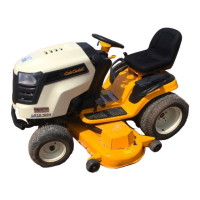

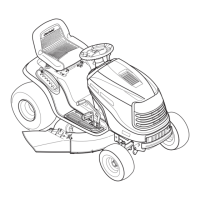
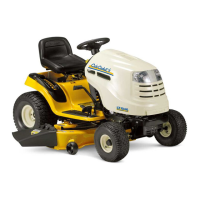
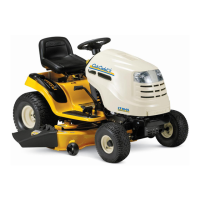
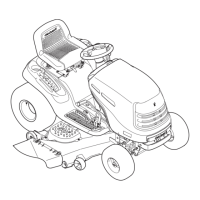
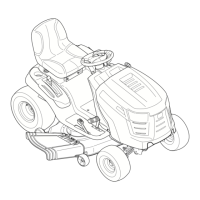
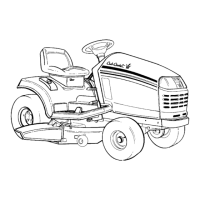
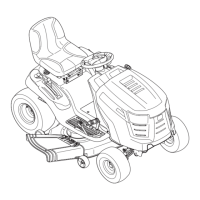
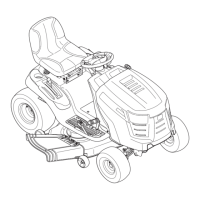
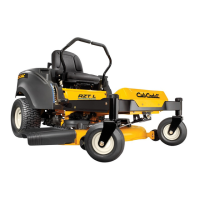
